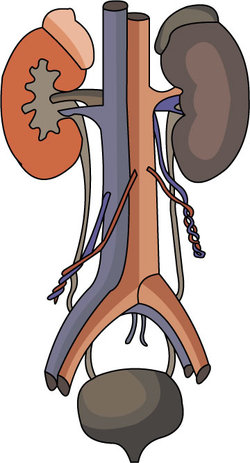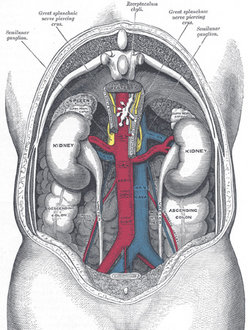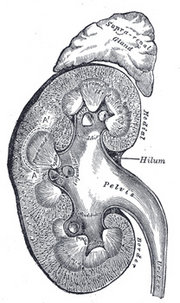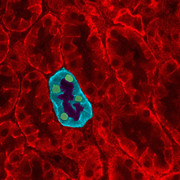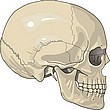Kidney
|
|
The kidneys are bean-shaped excretory organs in vertebrates. Part of the urinary system, the kidneys filter wastes (especially urea) from the blood and excrete them, along with water, as urine. The medical field that studies the kidneys and diseases affecting the kidney is called nephrology.
| Contents |
Basic anatomy
Location
In humans the kidneys are two organs located in the posterior part of the abdomen. There is one on each side of the spine just below the liver and spleen. Superior to each kidney is an adrenal gland (also called the suprarenal gland).
The kidneys are retroperitoneal, which means they lie behind the peritoneum, the lining of the abdominal cavity. They are approximately at the vertebral level T12 to L3, and the right kidney usually lies slightly lower than the left in order to accommodate the liver.
The upper parts of the kidneys are partially protected by the eleventh and twelfth ribs, and each whole kidney is surrounded by two layers of fat (the perirenal fat and the pararenal fat) which help to cushion it.
Structural details
In a normal human adult, each kidney is about 11 cm long and about 5 cm thick, weighing 150 grams. The kidneys are "bean-shaped" organs, and have a concave side facing inwards (medially). On this medial aspect of each kidney is an opening, called the hilus, which admits the renal artery, the renal vein, nerves, and the ureter.
Organization
The outermost portion of the kidney is called the renal cortex, deep to which lies the renal medulla. The innermost portion is the pelvis. The renal pyramids, which are actually openings of the collecting ducts, can be observed in the human renal medulla. The outside is covered by the renal capsule, which is a layer of loose connective tissue.
The basic functional unit of the kidney is the nephron, of which there are more than a million in each normal adult kidney. Nephrons regulate water and soluble matter (especially electrolytes) in the body by first filtering the blood, then reabsorbing some necessary fluid and molecules while secreting other, unneeded molecules. Reabsorption and secretion are accomplished with both cotransport and countertransport mechanisms. The final solution is then excreted as urine.
A nephron consists of an initial filtering component called the renal corpuscle (or Malpighian corpuscle), and a renal tubule that extends from the renal corpuscle.
Each renal corpuscle contains a compact bunch of interconnected capillaries called the "glomerulus", which protrudes into the Bowman's capsule. Each glomerulus is supplied with blood by an afferent (in-coming) arteriole. The capillary walls of the glomerulus have pores allowing filtration. Blood pressure provides the force for blood plasma to be filtered through the thin, porous epithelium of the glomerulus and the neighbouring Bowman's capsule wall to produce the glomerular filtrate, which enter the kidney tubule. Blood leaves the glomerulus through an efferent (out-going) arteriole.
The Bowman's capsule contains a fluid-filled space called "Bowman's space", which is separated from blood in the glomerulus by three layers:
- a single-cell capillary endothelium in the glomerulus
- a proteinaceous layer of basement membrane
- a single-cell epithelial lining of Bowman's capsule (these cells are called podocytes)
Due to pressure, fluid in the blood is forced out of the glomerulus, through these three layers and into the Bowman's space to form the glomerular filtrate.
The filtrate is blood plasma without blood cells and large-molecule proteins. Small proteins may be present. A person's blood pass through the kidneys 350 times a day at the rate of 1.2 litres per minute, producing 125cc of glomerular filtrate per minute. Measuring the glomerular filtration rate is a diagnostic test of kidney function.
The renal tubule is continuous with Bowman's capsule. The segment that drains glomerular filtrate from the Bowman's capsule is the proximal convoluted tubule. The next portion of the tubule is the loop of Henle, which leads to the distal convoluted tubule.
The loop of Henle was named after Friedrich Gustav Jakob Henle who described it in the early 1860s. The loop of Henle maintains an osmotic gradient set up as a countercurrent exchange to filter and concentrate glomerular filtrate. Cells lining the tubule have numerous mitochondria, enabling active transport to take place by the energy supplied by ATP. Glucose, amino acids, variable ammounts of mineral ions are thus returned to the body. 97.9% of the water in the filtrate enters the convoluted tubules and collecting ducts by osmosis.
Fluid flows from the distal convoluted tubule into the collecting duct system, which consists of:
The site where the ascending loop of Henle touches the afferent arteriole, is called the juxtaglomerular apparatus. It contains macula densa and juxtaglomerular cells. Juxtaglomerular cells are the site of renin synthesis and secretion.
Fluids become more concentrated along the tubules and ducts to form urine, which is then drained into the bladder via the ureter.
Homeostatic function of the kidney
The kidney regulates the pH, mineral ion concentration and water composition of the blood.
By exchanging hydronium ions and hydroxyl ions, the blood plasma is maintained by the kidney at pH 7.4. Urine, on the other hand, becomes either acidic at pH 5 or alkaline at pH 8.
Sodium ions are controlled in a homeostatic process involving aldosterone which increases sodium ion absorption in the convoluted tubule.
Any rise or drop in blood osmotic pressure due to a lack or excess of water is detected by the hypothalamus, which notifies the pituitary gland via negative feedback. The pituitary gland secretes antidiuretic hormone, otherwise known as vasopressin (or stops the secretion if water is in excess), which causes a change in the water absorption of the kidney tubule. Tissue fluid concentration thus returns to a mean of 98%.
Terms
- renal capsule: The membranous covering of the kidney.
- cortex: The outer layer over the internal medulla. It contains blood vessels, glomeruli (which are the kidneys' "filters") and urine tubes and is supported by a fibrous matrix.
- hilus: The opening in the middle of the concave medial border for nerves and blood vessels to pass into the renal sinus.
- renal column: The structures which support the cortex. They consist of lines of blood vessels and urinary tubes and a fibrous material.
- renal sinus: The cavity which houses the renal pyramids.
- calyces: The recesses in the internal medulla which hold the pyramids. They are used to subdivide the sections of the kidney. (singular - calyx)
- papillae: The small conical projections along the wall of the renal sinus. They have openings through which urine passes into the calyces. (singular - papilla)
- renal pyramids: The conical segments within the internal medulla. They contain the secreting apparatus and tubules and are also called malpighian pyramids.
- renal artery: Two renal arteries come from the aorta, each connecting to a kidney. The artery divides into five branches, each of which leads to a ball of capillaries. The arteries supply (unfiltered) blood to the kidneys. The left kidney receives about 60% of the renal bloodflow.
- renal vein: The filtered blood returns to circulation through the renal veins which join into the inferior vena cava.
- renal pelvis: Basically just a funnel, the renal pelvis accepts the urine and channels it out of the hilus into the ureter.
- ureter: A narrow tube 40 cm long and 4 mm in diameter. Passing from the renal pelvis out of the hilus and down to the bladder. The ureter carries urine from the kidneys to the bladder by means of peristalsis.
Renal functions
Renal functions include the excretion of waste material from the bloodstream, secretion of hormones - particularly erythropoietin and renin and maintaining serum electrolyte, acid-base levels and osmolality.
For more info see Renal physiology.
Diseases and disorders
Congenital diseases of the kidneys
- Polycystic kidney disease
- Congenital hydronephrosis
- renal dysplasia
- Congenital obstruction of urinary tract
- horseshoe kidney
- duplicated ureter
Acquired diseases of the kidneys
- Kidney stones are a relatively common and particularly painful disorder.
- Pyelonephritis is infection of the kidneys and is frequently caused by complication of a urinary tract infection.
- Azotemia is a toxic condition characterized by abnormal and dangerously high levels of urea, creatinine, various body waste compounds, and other nitrogen-rich compounds in the blood.
- Hydronephrosis is the enlargement of one or both of the kidneys caused by obstruction of the flow of urine.
- In nephrotic syndrome, the glomerulus has been damaged so that a large amount of protein in the blood enters the urine. Other frequent features of the nephrotic syndrome include swelling, low serum albumin, and high cholesterol.
- kidney tumors
- Renal failure (acute and chronic)
- Glomerulonephritis
- Diabetic nephropathy
- Lupus nephritis
Dialysis and kidney transplants
Generally, man can live fine with just one kidney. Only when the amount of functioning kidney tissue is greatly diminished will renal failure develop. If renal function is impaired, various forms of medications are used, while others are contraindicated. If creatinine clearance (a measure of renal function) has fallen very low ("end-stage renal failure"), or if the renal dysfunction leads to severe symptoms, dialysis is commenced. Dialysis is a medical procedure, performed in various different forms, where the blood is filtered outside of the body.
Kidney transplantation is the only cure for advanced chronic renal failure; dialysis, while correcting the abnormalities to a degree, is seen as a form of "buying time" to bridge the inevitable wait for a suitable organ.
The first successful kidney transplant was announced on March 4, 1954 at Peter Bent Brigham Hospital in Boston. The surgery was performed by Dr. Joseph E. Murray, who was awarded the Nobel Prize in Medicine in 1990 for this feat.
There are two types of kidney transplants: living donor transplant and a cadaveric (dead donor) transplant. A kidney from a donor, usually a blood relative, is transplanted into the patients body. The donor's blood group and tissue type must be compatible with the patients, and extensive medical tests are done to determine the health of the donor. The cadaveric transplant is healthy kidney from someone who has died is transplanted into the patients body. Before a cadaveric donor's organs can be transplanted, a series of medical tests have to be done to determine if the organs are healthy. Also, the family of the donor must give its consent for the organ donation. In both cases, the recipient of the new organ needs to take drugs to suppress their immune system and prevent their body from rejecting the new kidney [1] (http://www.mayoclinic.org/kidney-transplant/livingdonor.html).
Medical terminology
- Medical terms related to the kidneys either involve the prefixes renal or nephro-.
- Surgical removal of the kidney is a radical nephrectomy.
Anatomy Clipart and Pictures
- Clip Art (https://classroomclipart.com)
- Anatomy Illustrations (https://classroomclipart.com/clipart/Illustrations/Anatomy.htm)
- Anatomy Clipart (https://classroomclipart.com/clipart/Anatomy.htm)
- Anatomy Animations (http://classroomclipart.com/cgi-bin/kids/imageFolio.cgi?direct=Animations/Anatomy)
See also
| Urinary system |
|
Kidneys - Ureters - Urinary bladder - Urethral sphincters - Urethra |
| Endocrine system | |
| Adrenal gland - Corpus luteum - Hypothalamus - Ovaries - Pancreas - Parathyroid gland - Pineal gland - Pituitary gland - Testes - Thyroid gland |

